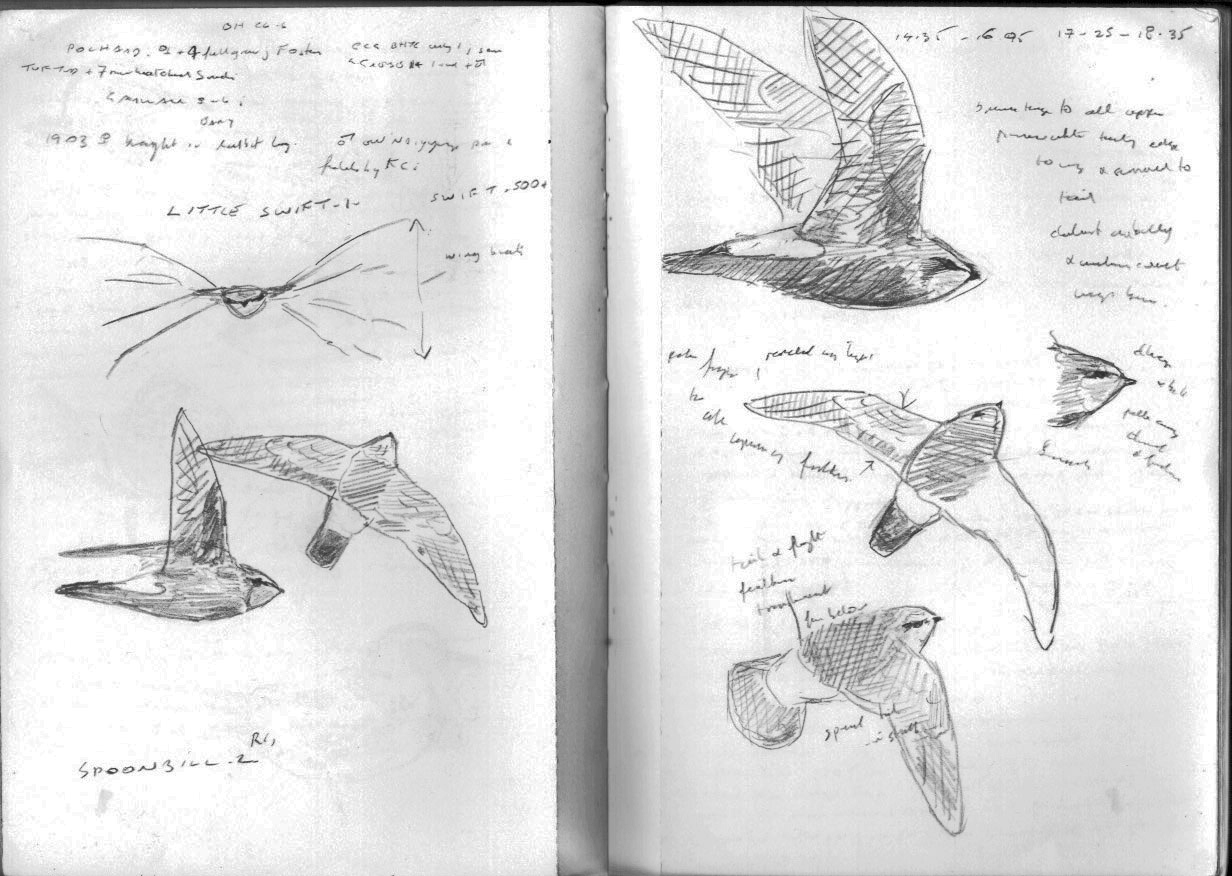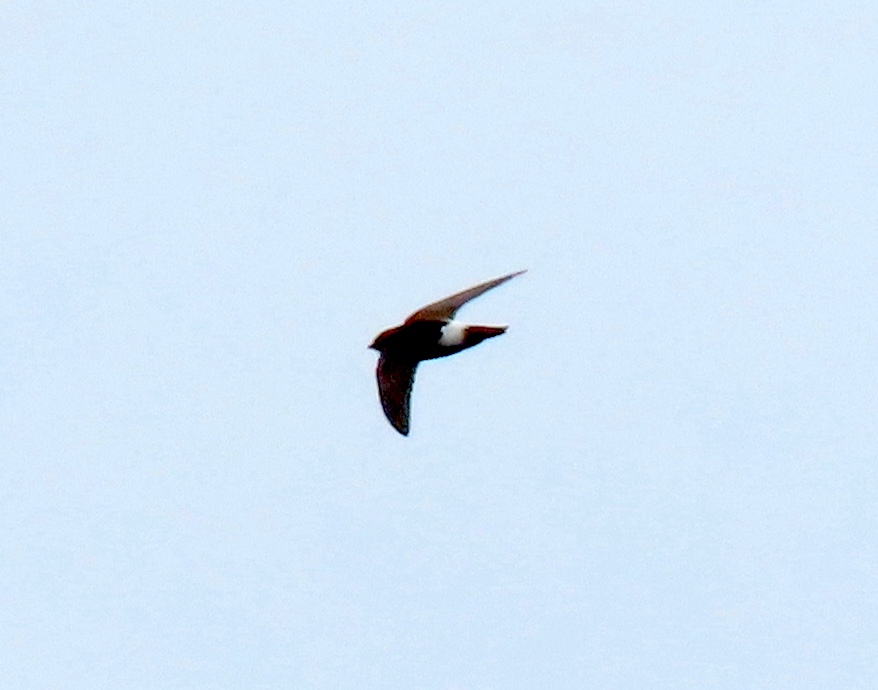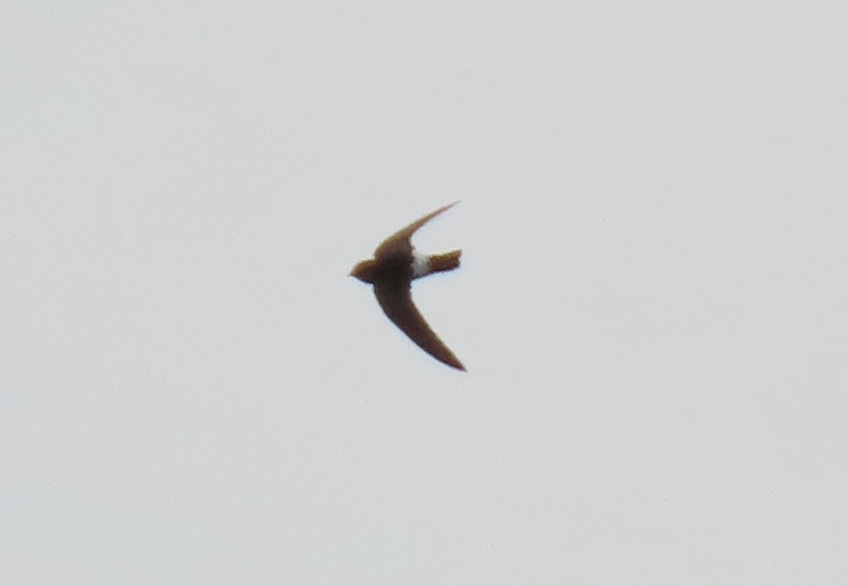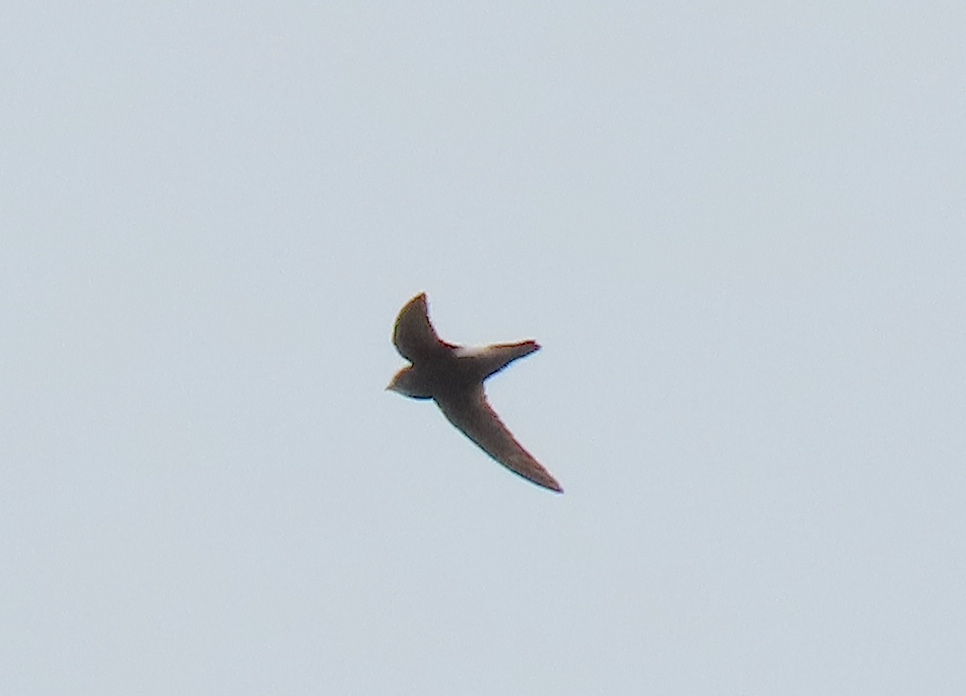Little Swift Apus affinis




| Site | First date | Last date | Count | Notes |
| Barton and Barrow Haven | 26/06/1998 | 1 | Present 14.30-19.15h only. | |
| The Mere, Gibraltar Point NNR | 25/06/2002 | 1 | ||
| Alkborough Flats | 29/06/2023 | 1 |
Finder’s report: Little Swift at Barton clay pits, June 26th, 1998, first county record
by G. P. Catley.
Note: This account is based on the original BBRC submission by the finder. The BBRC report for 1998 noted that the recent surge in records, with three in both 1997 and 1998, was rather puzzling. There had been just ten records from the first in 1967 up to 1996. This individual stayed for several hours, enabling many observers to catch up with this distinctive small swift.
Circumstances
On the afternoon of June 26th, I was trying to mop up any outstanding broods of wildfowl to complete the annual breeding survey of the clay pits. Dodging the regular thundery showers, I found myself sitting in the hide which looks westwards over Barrow Haven reedbed, at about 14.30 hr. as yet another downpour threatened to engulf the local environs. Scanning across the pit I realised that the Common Tern sitting on its nest on a brick pillar in the next pit to the west, about 700m. away, was visible from the hide – at least it would save me the trouble of walking through 700m. of wet grass to check progress. It was at this point that I realised that there were good numbers of Swifts feeding low over the Humber embankment which borders the next pit (No. 25) beyond the ski pit where the terns were nesting.
With over 20 yr. of regular summer swift scrutiny already having passed without reward, the news of three Alpine Swift fly-bys at Spurn in recent weeks had inspired renewed swift watching, but as usual to no avail. June 26th was not intended as a swift-watching day, but events suddenly took a turn swift-wards as a bird with a bright white rump flew literally flew through my ‘scopes field of view at over 1km. range. The view was so brief that I initially suspected that I had glimpsed a House Martin in strange light and had missed the white underparts. The day was thundery with dark, brooding black clouds passing quickly northeast intermixed with bright sunny spells and some glaring skyscapes. A quick scan soon revealed the bird again. It showed a bright white rump and appeared to have a contrast of blackish belly and silvery underwings but in size it was difficult to judge just how big it was at 1km. range. It did not appear strikingly different from the swifts nearby although judging which individuals were close to it was hard enough at such a range and with such fast moving birds.
At this point panic set in. In my past swift studies, I had located three with white rumps, one with a white belly and a couple with a variety of white areas elsewhere in the plumage. This bird looked too precise and distinct to suggest a partial albino swift and its immediate jizz was more reminiscent of a Little Swift. I needed to get a closer view, but the options were all fraught with problems and all relied on the bird staying put which, given the fast moving thundery showers, and the rapid movement of swift flocks in association therewith, seemed hopeful at best. Of the three possibilities, a run/walk along 1km. of bank would have left me (a) exhausted and (b) having to walk that distance back, plus having to alert more observers; driving 1.5 miles round to the next access point would get me about 300m. closer but would have taken a good five minutes; driving right round to the location where the bird was feeding was a good 5 miles by road and would take at least 10 minutes, but would pass close to a phone box en route. The second option won and after a quick 200m jog back to the car I raced down the rough tracks to the ski pit access and quickly located the swift, albeit still 700m. away. At this range with a 30x ‘scope however, I could see a broad white rump, short square-ended tail, and shorter, more rounded wing tips than the nearby Common Swifts. I was convinced that it was a Little Swift, not considering any similar African swifts, and thus set off on the 5 mile epic to get even closer. Calling at a phone box on the way I suffered a complete mental block on phone numbers and with just 30p in change got one answerphone and very dippy pager operator and a Birdline NE answerphone, where I left a message to the effect that I thought it best going out as a probable until I made 100% certain; shadows of large seagulls hung over the phone box.
Eventually arriving at the pit at about 15.10 hr. a desperate search failed to turn up any sign of the bird and it had still not materialised, but suddenly there it was low over the Humber Bank, coming towards me in bright light backed by a black sky giving unbeatable views. It fed over the water on Pit 25 for about 20 minutes and then as the sun came out it began to climb with the Common Swifts, and I lost sight of it as it passed across the sun. At this point, no-one that I had phoned had appeared and nothing had come on the pager, so I begged the use of a phone in the Sailing Club and rang Birdline. Again, no response! I thus returned to the bird and failed to locate it by 15.50 hr. but then it again appeared over the pit where I watched it to 16.04 hr. when it again disappeared. With still no response from any birders I decided to return home and ring more people, plus I had my daughter to collect from nursery and due to the mental block could not remember when!
Back home at 17.10 hr. a phone call came in saying that the swift could not be found in spite of 30 minutes of searching. I headed back down to the pits on bike and just as I arrived it was relocated flying back from the Barrow Haven direction. It was then seen almost continually with odd short absences until about 19.15 hr. (I left the site at 18.40 hr.) when heavy rain set in for over an hour after which it was not seen again. The number of Common Swifts present on 26th was certainly higher than in recent days with over 500 estimated, compared to about 300 over the last 2-3 weeks and it would appear that the Little Swift arrived with a mobile flock of Common Swifts in association with the thundery weather system affecting the area at the time.
Description
General appearance - judging size was not easy even with large numbers of Common Swifts present, possibly due to the constant changes in distance from adjacent birds and their rapid movements. When seen well however, it was obviously smaller than Common Swifts but nothing like as small as House Martin or Swallow. Wings shorter and blunter tipped, more rounded at the tip, while the tail was noticeably short and square-tipped, appearing to be cut off from the body by the large white rump. Flight was generally more fluttering with frequent glides, more like a House Martin than a Common Swift. Frequently when chasing insects, it would fly faster with rapidly beating wings as it gained height before snapping at prey above it in the air. Several times it was noted preening its upperparts and breast feathers in flight, stalling with spread tail as it did so. Usually flying at about 20-50 feet but going higher in sunny spells. It also fed low over the water, 2-3 feet over the surface, during the earlier observations when the weather was dull.
Head - appeared neat and rounded with a small but clearly visible bill when close; the latter was no doubt a factor related to its dark colouration and pale forecrown, chin and face. Whole of the front of the head appeared pale when head on apart from a dark line through to the dark eyes. Ear coverts seemed pale as did forecrown, contrasting with dark grey lores, dark eyes, eye sockets and eye stripe.
Upperparts - from mid-crown back to uppertail coverts was all blackish-brown, darker than all the upperwing. Upperwings appeared all dark brown but when seen close in good light all of the coverts seemed to have pale tips forming a scaly pattern with a very narrow trailing edge to the secondaries in particular. In more distant views, upperwings looked dark brown but still contrasted slightly with blacker mantle/ back. Rump patch strikingly white, broad, and wrapped around on to the rear flanks, being visible from all angles, even directly below the bird. Tail short and square-ended, looked brown, but when close it had a narrow pale tip and appeared to show a pale outline along the outer web of the outermost feathers. When the bird stalled in flight to preen or to catch insects, the tail was sometimes spread revealing a rounded outline (see Graham’s sketches, above).
Underparts - chin and throat were pale, sullied with grey and not strikingly white. According to Chantler and Driessens (Swifts: a guide to the Swifts and Treeswifts of the world) ‘worn individuals show a mottled grey throat patch’. The breast, belly and underwing coverts were blackish, the darkest parts of the bird, contrasting with the underside of the flight feathers and tail, which all appeared greyish and almost translucent when seen against the light. The white of the rump sides, visible on the rear flanks, was striking as it flew away against the dark sky and created a very storm petrel-like impression.
References
Catley, G.P.C. (Undated). Little Swift at Barton, June 26th 1998. Lincolnshire Rare & Scarce Bird Report 1997-1999, pp 58-59.
Wilson, K (Undated). Little Swift at Gibraltar Point NNR, June 25th 2002. Lincolnshire Rare & Scarce Bird Report 2000-2002, pp71-72.
(Account as per new Birds of Lincolnshire (2021), included September 2022)

